Do you want to train at home and are looking for the best bodyweight exercises and workout routines? Look no further. In this ultimate guide, we will show you how to make your body stronger and look better by using only your body weight.
Our bodyweight workout beginner guide will teach you proven tips and techniques that will help you maximize muscle gain and lose fat.
These highly effective exercises have been used for centuries, dating back to ancient physical training practices.
They target different muscle groups and are suitable for people of all fitness levels, ages, and abilities.
Some common examples of bodyweight exercises include:
- Push Ups: Target the chest, shoulders, and triceps.
- Pull Ups or bodyweight rows: Target the back and biceps.
- Squats: Target the quadriceps, hamstrings, and glutes.
- Lunges: Target the legs and glutes.
- Planks: Target the core muscles, including the abs and lower back.
- Burpees: Engage multiple muscle groups and provide cardiovascular benefits.
- Dips: Target the triceps and chest.
- Mountain climbers: Provide a dynamic workout for the core, shoulders, and legs.
- Glute bridges: Activate the glute muscles and help improve hip stability.
- Jumping jacks: Serve as a full-body warm-up exercise……. AND MANY MORE.
Get ready to challenge your muscles, improve your endurance, and transform your physique.
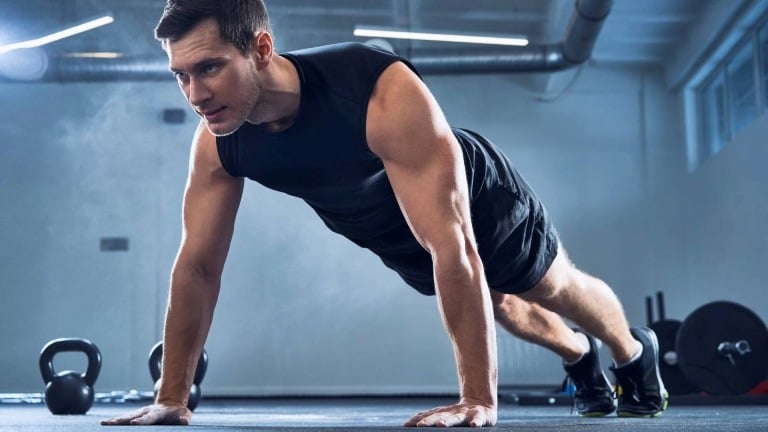
- How To Do Bodyweight Workout At Home
- Bodyweight Exercises To Build Mass and Strength
- 1. Push-Ups
- 2. Pull-Up
- 3. Inverted Row
- 4. Bodyweight Bicep Curl
- 5. Pike Push Up
- 6. Bench Dip
- 7. Bodyweight Squat
- 8. Bodyweight Standing Calf Raise
- 9. Hip Bridge
- 10. Good Morning
- 11. Plank
- 12. Side Plank
- 13. Bicycle Crunch
- 14. Lying Straight Leg Raise
- Bodyweight Exercises To Improve Endurance
- 15. Cross-Body Mountain Climber
- 16. Jumping Rope
- 17. Jumping Jacks
- 18. High Knees
- 19. Inchworm
- 20. Burpees
- How To Make Bodyweight Workout Routines
- 1. Select Workout Schedule (Split)
- 2. Workout Volume
- 3. Frequency
- 4. Progressively Overload The Muscles
- 5. Be Flexible
- 6. Recovery
- 12-Week Bodyweight Workout Program
- Bodyweight Workout Week 1-4: Laying the Foundation
- Bodyweight Workout Week 5-8: Progression and Intensity
- Week 9-12: Advanced Bodyweight Training
- FAQs
- Can I do bodyweight exercises if I’m overweight or obese?
- Can you build muscle mass with bodyweight exercises?
- What are the big 5 bodyweight workouts?
- How long should I do bodyweight?
- Should beginners start with bodyweight?
- Do bodyweight exercises burn more fat than weights?
- Which bodyweight exercises burn the most fat?
- Takeaways
- References
How To Do Bodyweight Workout At Home
According to a research review from 2016, incorporating strength training at least 2 days a week is considered optimal for muscle growth.
If you’re starting out, do 2 or 3 days of weight training and 2 days of cardio. Then, rest for 2 days to recover.
As your strength increases and you gain more experience, it may be worthwhile to increase your workout days and explore the possibility of dividing your workouts between the upper and lower body.
It’s still crucial to prioritize rest and recovery, so be sure to allocate at least 2 days per week for that purpose.
| Fitness level | Exercises |
| Beginner | 4–5 days a week of strength training + 2-3 days of cardio |
| Intermediate | 4–5 days a week of strength training + 2-3 days cardio |
| Advance | 3–4 days a week of split strength training + 2-3 days of cardio |
To structure a bodyweight workout to increase mass, strength and endurance, the number of reps and sets will vary based on your fitness level, weekly workout frequency, and strength training goals.
Bodyweight Exercises To Build Mass and Strength
You can do many bodyweight exercises at home to lose fat, build strength, improve cardiovascular fitness, and increase flexibility.
1. Push-Ups
Push-ups can be performed regardless of where you are, and, best of all, they are completely free—no expensive equipment or annual gym fees required. There are different types of push-up variations to meet different needs.
The classic push-up has survived the test of time and is the single most efficient exercise for simultaneously strengthening the chest, arms, deltoid, lower back, abs, and glutes.
Push-ups are one of the most basic but rewarding all-around exercises you will find, and everyone from teenagers to older adults can benefit from doing them regularly.
Different Push-Up For A Complete Workout
- Wall Push-ups and knee push-ups are the best types of push-ups for beginners.
- Standard push ups are best for strengthening the chest, shoulders, and triceps.
- Incline Push Up works your lower chest and back more.
- Decline push-up works the upper chest and front shoulders
- Close grip and diamond Push ups focus more on the tricep and inner chest than the shoulder.
- Wide grip push-ups focus more on the outer chest and shoulder.
- Reverse Type Push up is considered the bicep push-up.
- Pike Push-ups focus more on the shoulder than the chest and tricep.
- Hindu push-up works from your whole body, from upper to lower body; it works from your front to back.
- Single-Leg Push Up, One Arm Push-Up, and Clapping Push-Up Types of Push-Up are best for advanced athletes.
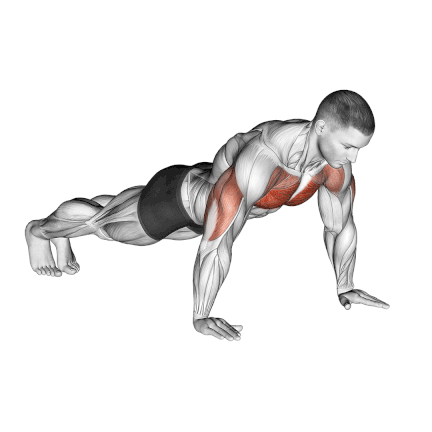
How To Do
- Lay face down on the ground with your legs straight and arms supporting your upper body.
- Keep your knees off the ground. Keep your elbows close to your body.
- Raise yourself off the ground, straightening your elbows and your arms.
- Now, lower your body under slow, sustained motion, feeling the motion all the way down until your chest is very close to the ground.
- Raise until your elbows are locked, and pause momentarily at the movement’s top.
Read More: Bodyweight Chest Exercises: Beginner To Advance
2. Pull-Up
The pull-up is an upper-body strength movement that targets your back and arms. They are often a challenge for beginners and even experienced athletes to perform.
The pull-up increases the strength, thickness, and width of your back, specifically your lats. The lats influence the back width and form the “V” in the upper back.
Variations on pull-ups for a full-body workout.
- Standard Pull-Up: Classic upper body exercise.
- Chin-Up: Palms face you, focusing on the biceps.
- Wide Grip Pull-Up: Hands wider than shoulder-width.
- One-arm Pull-Up: Doing pull-up with a single hand.
- Archer Pull-Up: Shift weight to one side mid-pull.
- L-sit Pull-Up: Lift legs into an L shape.
- Muscle-Up: Transition from pull-up to dip.
- Typewriter Pull-Up: Move side-to-side at the top.
- Towel Pull-Up: Grip towels instead of a bar.
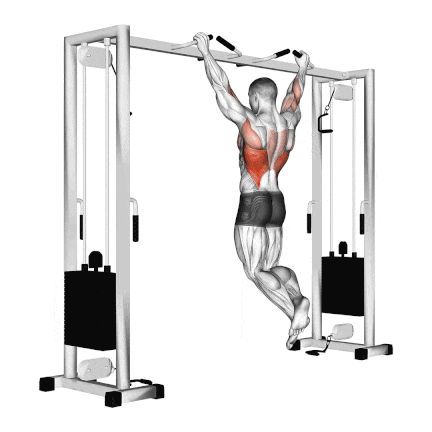
How To Do
- Using an overhand grip, grab a pull-up bar with your hands positioned shoulder-width apart.
- Hang from the bar with your arms out and your chest up. Make sure your lower back is straight.
- To reduce biceps involvement, use a thumbless grip.
- Pull yourself up by squeezing your shoulder blades together and contracting your lats until your chin passes the bar.
- Go with the full range of motion and keep the form correct.
- Hold the contraction at the top for a second before slowly lowering yourself back to the starting position.
3. Inverted Row
Pull-ups are a challenging upper-body exercise that requires a lot of strength, making them intimidating for many people.
The good news? The inverted row (bodyweight rows) puts your body horizontally, making it easier to perform. It works the back and shoulder muscles from a different angle and improves upper body strength.
You can easily adjust the difficulty by changing the angle of your body. A higher incline makes it easier while lowering the incline increases the challenge.
Inverted Row Variations:
- Standard Inverted Row
- Wide Grip Inverted Row
- Close Grip Inverted Row
- Feet Elevated Inverted Row
- Single-Leg Inverted Row
- Typewriter Inverted Row
- TRX or Suspension Trainer Inverted Row
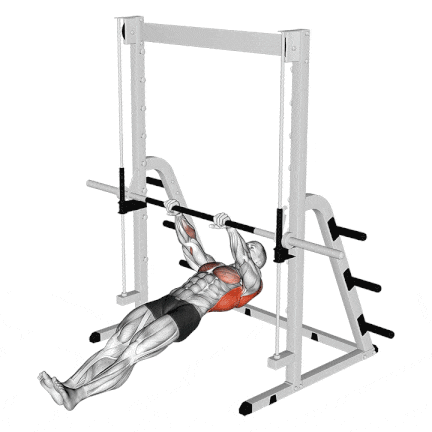
How To Do
- Adjust the height of the chair and bar so that it’s a little higher than arm’s length from the floor.
- Lie under the bar with your legs and body straight.
- Grasp the bar with an overhand grip that’s a little wider than shoulder width.
- Keeping your legs and body straight, exhale as you pull your chest up to the bar.
- Hold for a count of two and squeeze your back muscles.
- Breathe in as you lower your body until your arms and shoulders are fully extended. Repeat.

Know More: 15 Best Bodyweight Back Exercises To Build Mass And Strength
4. Bodyweight Bicep Curl
The bodyweight bicep curl is a very effective bodyweight isolation exercise for building muscle and strength. Unlike traditional bicep curls, which use dumbbells or barbells as resistance, this exercise relies solely on your body weight.
Sometimes we may not have access to equipment, but that is not an issue with the bicep curl, as you only need your arms and legs.
Since both arms work independently, bodyweight bicep curls help identify and address any muscular imbalances.

How To Do
- Begin by sitting on a chair as close to the edge as possible.
- Then, place your right hand under your left thigh at the crease between your hamstrings and calves.
- Slowly curl your right up as high as you can. Exhale during this portion of the exercise.
- Hold for a couple of seconds. Then, slowly lower your leg back down, so your foot is just above the ground. Inhale during this portion of the exercise.
- Repeat for the desired number of reps. Repeat the exercise with your left arm.
- You can perform a variation of the bicep leg curl lying down.
5. Pike Push Up
Pike push-ups, also known as shoulder push-ups, are a variation of the push-up that increases strength and stability in the shoulders.
Performing the exercise more uprightly will target the shoulders more than the chest.
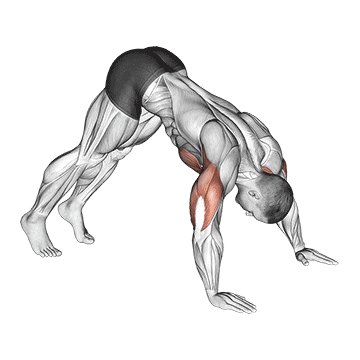
How To Do
- Start in a standard push-up position with your hands slightly wider than shoulder-width apart and elbows completely locked out.
- Lift the hips up and back until your body forms an inverted V shape. Keep arms and legs as straight as possible.
- Slowly lower the top of your head towards the ground. Once your head is about to make contact with the ground, pause for a second.
- Then slowly push back until your arms are straight, and you’re in the inverted V position.
Read More: 21 Bodyweight Shoulder Exercises: Beginner To Advance
6. Bench Dip
Are you looking for the best exercise to build stronger arms? Bench dips may be your answer.
Bench dips are a simple exercise that can be done almost anywhere and have many variations to match your fitness level. Use it as part of a strength workout for your upper body.
The tricep bench dip is a bodyweight triceps exercise that you can also overload by placing weight plates over the legs, making it a useful exercise for individuals of varying strengths and experience levels.
When performed with strict form, the bench dip is an effective exercise to build your triceps (the back part of your arms), even if using bodyweight alone. It will also target the shoulders (particularly the anterior delt heads), chest (pectorals), and serratus anterior.
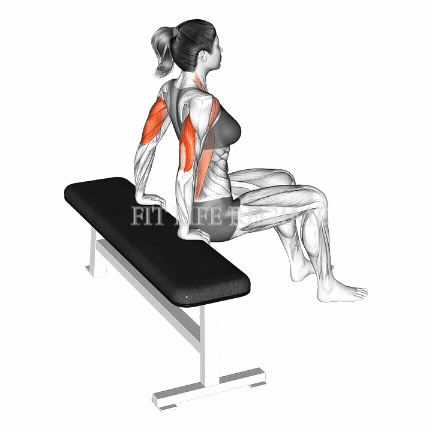
How To Do
- Place your hands on the side of a flat bench so that your body is perpendicular to the bench when you place your feet out in front of you.
- Only your heels should be on the floor and your legs should be straight. Keep your knees and hips bent.
- Your arms should be fully extended with just your palms on the bench.
- Bend your elbows to lower your body down until your elbows reach 90 degrees.
- Now, extend your arms to lift your body back to the starting position, flexing your triceps hard at the top.
7. Bodyweight Squat
The Bodyweight squat is a type of resistance training that works the lower body, specially the quadriceps, hamstrings, and glutes. It is a compound exercise, which means that it works for multiple muscle groups at the same time.
Bodyweight squats are a great exercise for beginners and experienced exercisers alike. They are a simple, effective way to work your legs and glutes.
Bodyweight Squat Variations To Build Leg
- Standard Bodyweight Squat: Classic squat position.
- Sumo Squat: Wide stance with toes pointed out.
- Narrow Stance Squat: Feet close together.
- Bulgarian Split Squat: One leg elevated behind.
- Pistol Squat: Single-leg squat, other leg extended.
- Jump Squat: Explosive jump at the top of the squat.
- Paused Squat: Hold the squat position briefly.
- Hindu Squat: Heels elevated, knees over toes.
- Cossack Squat: Side-to-side squatting motion.
- Curtsy Squat: Cross one leg behind the other.
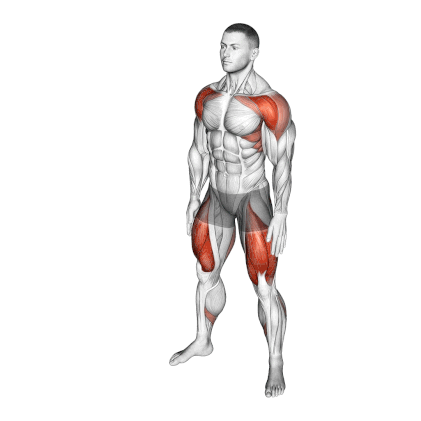
How To Do
- Stand with your feet hip-width apart, with your toes pointing forward.
- Keep your chest up and shoulders back, and engage your core.
- Slowly lower your body by bending your knees as if you were sitting back into a chair.
- Keep your back straight and your knees aligned with your toes.
- Lower your body as far as you can without letting your heels come off the ground or your knees to go over your toes.
- Push through your heels to return to the starting position.
Know More: Bodyweight Leg Exercises For Mass, Strength And Power
8. Bodyweight Standing Calf Raise
Standing calf raises (also known as heel raises) is a classic move, even bodyweight calf raise exercises are an effective way of strengthening your calves because the calf muscles take on so much of your bodyweight.
The standing calf raise is a really easy exercise to do. They only use body weight, so they’re a convenient calf exercise you can do at home or anywhere.
Bodyweight calf exercises are handy to exercise your calves without setting foot in the gym.
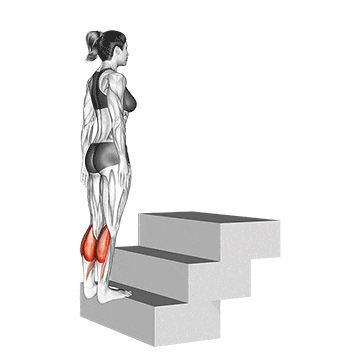
How To Do
- Stand up straight with your feet facing forward and placed hip-width apart.
- Keep a slight bend in your knee and hold your hands by your side
- Raise your heels by pressing the balls of your feet into the ground.
- You should raise your body until you are on your toes.
- Pause and squeeze for a count of 1-2 at the movement’s top for added intensity.
- Slowly lower your heels back to the ground.
9. Hip Bridge
Strong glutes and hip muscles are essential for various athletic activities, including running, jumping, and change of direction movements.
A hip bridge, also known as a glute bridge, is a good starter move for glutes, hip, hamstring, and low back muscles.
Research shows high gluteal muscle activity during a single-leg bridge compared to other gluteal strengthening exercises.
To make bodyweight leg workouts more interesting and challenging, try experimenting with:
- Stability Ball Hip Bridge
- Weighted Hip Bridge
- Marching Hip Bridge
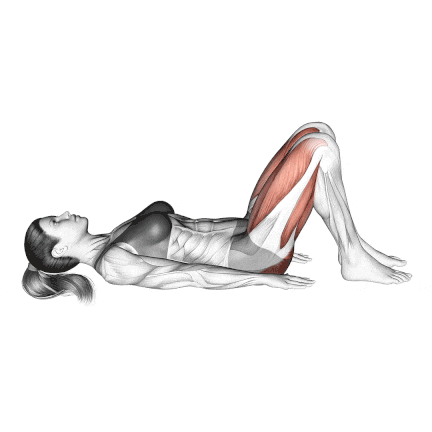
How To Do
- Lie face up on the floor, with your knees bent and feet flat on the ground.
- Keep your arms at your side with your palms down.
- Lift your hips off the ground until your knees, hips, and shoulders form a straight line. Do not push with your arms.
- Squeeze those glutes hard and keep your abs drawn in, so you don’t overextend your back during the exercise.
- Hold your bridged position for a couple of seconds before easing back down.
- Hold a weight plate on your lap to make the Hip bridge exercise more difficult.
10. Good Morning
Good morning exercise is one of the best bodyweight hamstring exercises for muscle mass and strength. It is also an effective way to train the lower back muscles.
It is known as a good morning because of the movement in the erector spinae which resembles the rise out of the bed to stretch.
You will exercise your glutes and hamstrings through a wide range of motion, which will improve your muscle-building potential and increase your posterior strength.
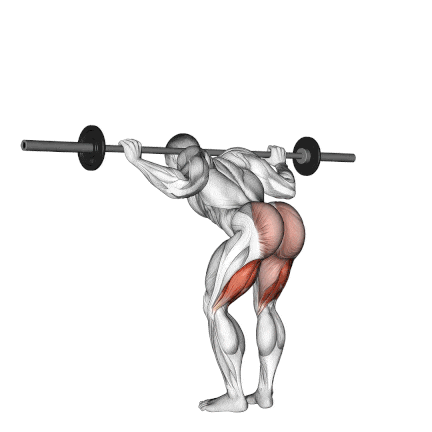
How To Do
- Stand with a stick or weight on the back of your shoulders and grasp the stick at each side. You can also perform the exercise using body weight.
- With your knees slightly bent and your back and neck neutral, inhale and lower your torso until it is close to or fully horizontal.
- Exhale as you raise your torso back up to the starting position by extending your hips.
- It is recommended that the lifter avoid rounding (flexing) or rotation (twisting) at any point during the movement.
- Keep the movement slow, the form strict, and the weight light.
11. Plank
The front plank is one of the most popular core exercises for men. It is a brilliant bodyweight exercise that is isometric and helps develop core strength and stability.
The exercise is more of a strength-building exercise than a cardio exercise. Engaging a range of muscles can also help to boost your calorie burn.
Variations of Plank for Beginners:
- Knee Plank
- High Plank on Knees
- Side Plank on Knees
Advanced Variations of Plank
- Side Plank with Leg Lift
- Plank Jacks
- Spiderman Plank
- One-Legged Plank
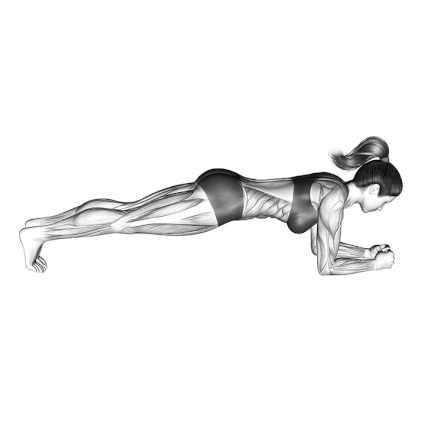
How To Do
- Start to get in a push-up position, but bend your elbows and rest your weight on your forearms instead of on your hands.
- Do not let your lower back sag or your butt rise. Ensure your body is straight and rigid.
- Your neck should be aligned with your body, not tilted up, which could strain the neck.
- Brace your core by contracting your abs as if you were about to be punched in the gut.
- Hold this position as directed. Keep your glutes and core muscles contracted.
12. Side Plank
The side plank is one of the best core exercises for strengthening the oblique, abs and glute muscles.
You will hold your body on your side in a straight position, supported only by one arm and the side of one foot.
If you’re a beginner to planking, you should master the basic forearm plank before moving on to the side plank variation.

How To Do
- Get in a side plank position by lying on your right side on the floor, with your left foot resting on top of the inner side of your right foot.
- Raise your body by placing your right forearm flat on the floor to be perpendicular to your torso.
- Lift your torso until your right upper arm is straight underneath you, with your elbow bent 90 degrees and your forearm flat on the floor.
- In this position, only your right forearm and the outer side of your right foot contact the floor, and your body forms a diagonal line at about a 20-degree angle to the floor.
- Keep your abs pulled in tight and hold this position for as long as you can, and then repeat on the left side.
13. Bicycle Crunch
The bicycle crunch works out your abs, rectus femoris, obliques, and Intercostal.
To make the exercise easier, you can make the angle between your knees smaller, and to make the exercise harder, you can make the angle between your legs larger.

How To Do It
- Lie on the floor with your legs straight and low back are flat on the floor.
- Keep your neck neutral and your lower back pressed against the floor.
- Place your hands behind your head and raise your feet and upper back a little off the floor.
- Make sure that you don’t pull your neck with your hands, else you can get a neck strain.
- Slowly start raising your knees at about a 45-degree angle.
- Go through a bicycle pedalling motion with your legs as you alternately touch your elbows to the opposite knees, twisting back and forth.
Know More: 18 Abs Exercises You Can Do At Home Without Equipment
14. Lying Straight Leg Raise
Lying leg raises are touted as killer abs exercises, but your hip flexors actually reap some major benefits. So don’t be surprised if your hips feel a bit of the burn during this one.
It mainly works on the lower part of your abs, making it stronger and more toned. It also strengthens the muscles of the upper thigh, the quadriceps, without placing any stress on the knee joint.
You don’t need anything special to do a straight leg raise. All you need is a place where you can lie on your back.
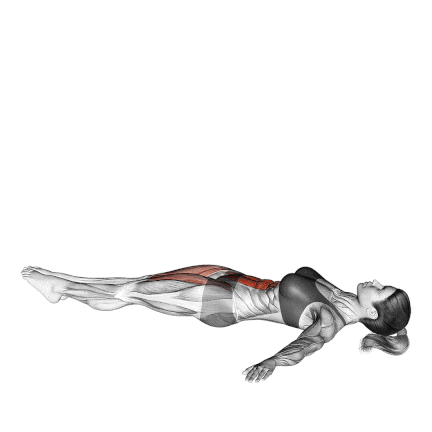
How To Do
- Lie flat on your back on a mat or the floor with your legs extended and your arms by your sides.
- Keep your legs straight and together.
- Engage your core muscles and lift both legs upward towards the ceiling.
- Hold your legs a few inches off the floor.
- Continue lifting until your legs are perpendicular to the ground or until you feel tension in your abs.
- Slowly lower your legs back down to the starting position.
Bodyweight Exercises To Improve Endurance
15. Cross-Body Mountain Climber
The cross-body mountain climber is a dynamic exercise that targets the entire core, including the abs, obliques, and hip flexors.
The cross-body mountain climber can improve balance, agility, coordination, strength, flexibility, and blood circulation by engaging multiple muscle groups at once.
To increase the intensity, perform the exercise faster or bring your knees in toward your elbows with a slight hop.
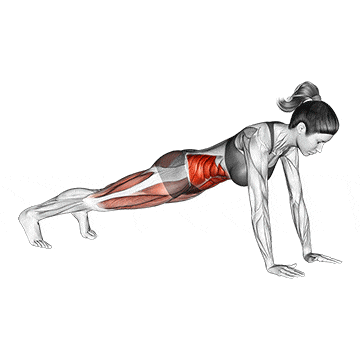
How To Do
- Start in a high plank position with your hands directly beneath your shoulders.
- Your body should form a straight line from your shoulders to your ankles.
- Squeeze your abs, lift one foot off the floor and bring your left knee towards your right elbow.
- Return to the starting position and immediately bring your right knee toward your left elbow, again crossing your body diagonally.
- Continue alternating the movement, bringing each knee toward the opposite elbow in a controlled and rhythmic manner.
Tips
- Don’t round your lower back.
- Don’t lift your hips too high. Your body should form a straight line from your shoulders to your ankles.
- Maintain a steady and controlled pace, focusing on proper form rather than speed.
16. Jumping Rope
Jumping rope utilizes muscles that the seated calf raises miss. It builds endurance for the calf muscles, as well as strength and coordination.
Furthermore, jumping rope provides endless variations to keep the exercise challenging.
To jump rope, the individual must first make sure that the rope is the appropriate length for their height.
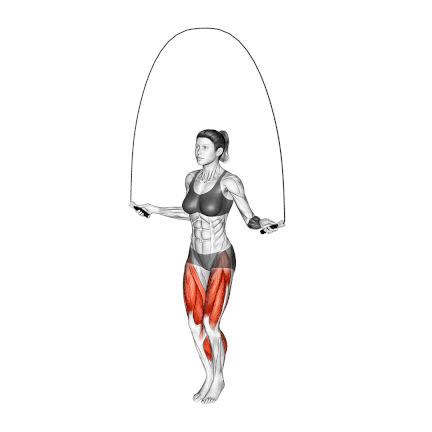
How To Do
- Hold the rope while keeping your hands at hip level.
- The knees must remain slightly bent, to land softly and to keep it from locking.
- Rotate your wrists to swing the rope and jump.
- The rope is flicked over the head and passed under the feet by pushing the toes into a quick but gentle hop.
- Jump with both feet simultaneously, one foot at a time, alternating between feet, etc.
- Repeat until the set is complete.
- For a low-impact exercise, focus on doing faster and smaller jumps.
17. Jumping Jacks
Jumping jacks are an efficient total-body workout that you can do almost anywhere. This exercise is part of what’s called plyometrics, or jump training. Jumping jacks also involve your abdominal and shoulder muscles.
Jumping Jacks are a great full-body exercise that enhances aerobic fitness, strengthens the body, and promotes relaxation. This workout also strengthens your muscles, boosts your metabolism, and aids in shedding love handles and sculpting your obliques.
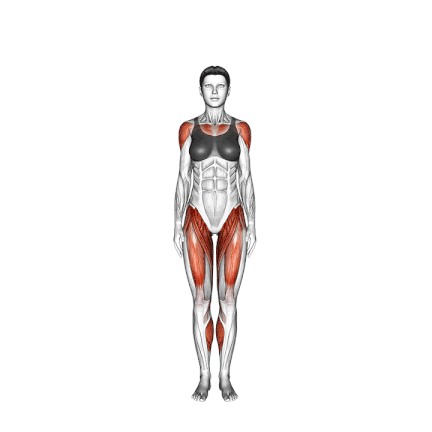
How To Do
- Stand straight with your feet together and hands by your sides.
- Jump up, spread your feet and bring both hands together above your head.
- Jump again and return to the starting position.
- Repeat until the set is complete.
- So, this is the last exercise, guys. Push it as hard as you can.
- Keep the knees slightly bent and land softly on the balls of your feet.
- Start with a comfortable pace and gradually increase the speed.
18. High Knees
High knees is an excellent bodyweight full-body movement that increases your heart rate, warms the muscles in your lower and upper body. It is suitable for people of all fitness levels because all you need to do is lift your body weight to burn love handles.
It engages your core, strengthens all the muscles in your legs, and improves momentum, coordination, and flexibility.
Furthermore, it can be done anywhere without any equipment, and it will fit into your busy schedule.
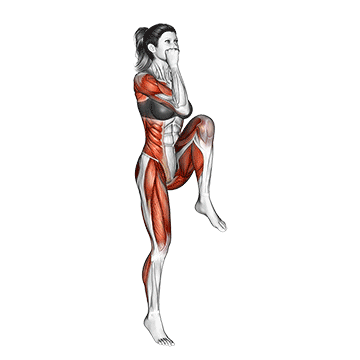
How To Do
- Stand with your feet hip-distance apart and start to jog in place.
- As you do so, bring up one knee towards your chest, then switch legs when the other knee comes up.
- With each high knee, trying to bring the knee up as high as possible while keeping a steady rhythm and maintaining your balance.
19. Inchworm
The Inchworm is a full-body exercise that increases strength and flexibility.
Your body weight is the only gym equipment you need to perform this low-impact exercise, which is highly effective.
Inspired by the rhythmic movements of inchworms, this move covers all the bases: core, arms, chest, and upper back.
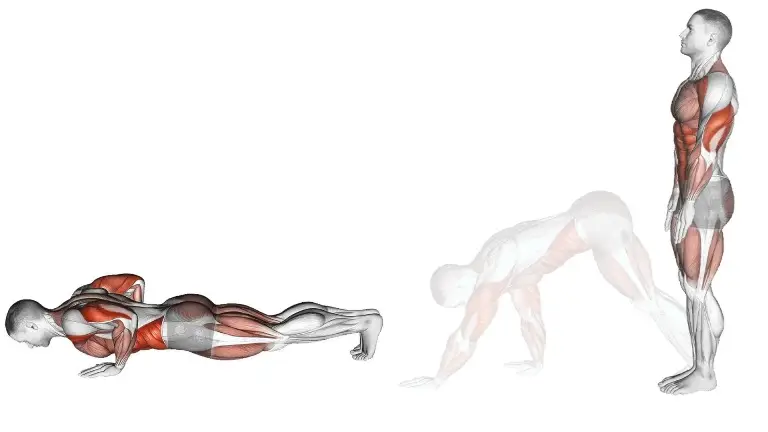
How To Do It
- Stand tall, your feet hip-distance apart. Hinge forward at your hips and place your palms on the mat. You can bend your knees if needed to get your palms flat on the floor.
- Walk your hands forward so that you’re in a high plank. Your body should form a straight line from your shoulders to your ankles. Contract your abs to brace your core.
- Walk your hands back in toward your feet, keeping your legs as straight as possible.
- Roll back up to a standing position.
- Try to avoid your torso from swaying from side to side during the exercise.
20. Burpees
Stand with your feet shoulder-width apart and your arms at your sides.
Lower your body down into a squat, then place your hands on the ground and jump your feet back into a plank position.
Do a push-up, then jump your feet back up to your hands. Stand up and jump with your arms above your head.
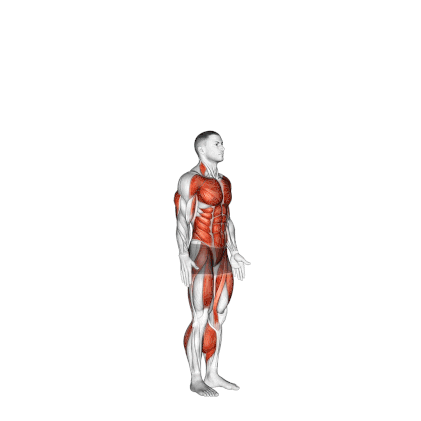
How To Make Bodyweight Workout Routines
To design a bodyweight workout program, you should consider several key factors, including exercise selection, volume, frequency, and progression.
Here are some tips for structuring an effective bodyweight workout plan:
1. Select Workout Schedule (Split)
Choose a workout split to train different muscle parts, such as the chest, back, shoulder, arms, and leg muscles.
- A 3-4 days workout split provides enough training stimulus while providing adequate recovery time.
- For beginners, full-body workouts on each training day can be effective. This approach ensures that all major muscle groups are targeted in each session.
- Upper/Lower split: With this split, you work on your upper body on one day, followed by your lower body the next time you train. Then, you repeat the process.
2. Workout Volume
The volume of your workout program refers to the number of sets, reps, and exercises performed in each workout.
The theoretical recommendations appear to be 8-20 weekly sets per body part for a beginner and 10-25 weekly sets per body part for an advanced lifter.
However, science also clearly shows that some people do better individually with low—or high-volume training. Finding your individual optimal volume will help you grow the most muscle.
A good starting point is to perform 3–4 sets of each exercise for 8–12 reps. Gradually increase the volume over time to promote muscle growth and adaptation.
3. Frequency
How often you perform leg workouts depends on your fitness level and goals.
- For beginners, 3-4 workouts per week are recommended,
- For intermediate levels, it is recommended to do 4-5 workouts per week.
- While advanced lifters may benefit from 5-6 Bodyweight workouts per week.
4. Progressively Overload The Muscles
It’s important to add progression and variations to your bodyweight workouts to keep challenging your muscles and making progress.
- As you get stronger, gradually increase the number of reps and sets you perform for each exercise.
- You can add weight to increase the resistance (challenging). You can use a weighted vest, dumbbells, or resistance bands.
- There are many ways to modify bodyweight exercises to make them more difficult. For example, you can perform one-legged squats instead of regular squats, or decline push-ups instead of regular push-ups.
5. Be Flexible
Life happens, and unexpected events may disrupt your plan. Be flexible and adaptable. If you miss a workout, don’t get discouraged; just resume your plan when you can.
Consistency is essential, but it’s okay to adjust if you stay on track with your goals.
6. Recovery
Adequate rest and recovery are important for muscle growth and injury prevention. Allow for at least one day of rest between workouts and prioritize sleep, nutrition, and hydration to support recovery.
12-Week Bodyweight Workout Program
Bodyweight Workout Week 1-4: Laying the Foundation
You are welcome to the first phase of your 12-week bodyweight workout routine. These initial weeks are all about building a solid foundation for your fitness journey.
Whether you’re a beginner or have some prior experience, focusing on fundamental exercises and proper form is crucial to ensure you progress safely and effectively.
Let’s dive into what Week 1-4 of your bodyweight training will look like:
Week 1
| Day | Exercise | Sets | Reps |
|---|---|---|---|
| Day 1 | Warm-up | 3 | 60 sec |
| Incline Push-ups | 4 | 8-10 | |
| Squats | 3 | 10-12 | |
| Knee Plank | 3 | 30 sec | |
| Day 2 | Warm-up | 3 | 60 sec |
| Lunges (each leg) | 3 | 8-10 | |
| Bicycle Crunches (each side) | 3 | 12-15 | |
| Day 3 | Rest day or light cardio | ||
| Day 4 | Warm-up | 3 | 20 sec |
| Close Grip Push-ups | 4 | 8-10 | |
| Glute Bridges | 3 | 12-15 | |
| Russian Twists | 3 | 15-20 | |
| Day 5 | Warm-up | 3 | 40 sec |
| Shoulder Tap Push Up | 3 | 8-10 | |
| Pull Ups | 3 | 6-8 | |
| Side Plank (each side) | 3 | 20 sec | |
| Day 6 | Rest day or light cardio | ||
| Day 7 | Rest day |
Week 2
| Day | Exercise | Sets | Reps |
|---|---|---|---|
| Day 1 | Warm-up | 3 | 30 sec |
| Inverted Rows | 4 | 8-10 | |
| Bulgarian Split Squats (each leg) | 3 | 10-12 | |
| Mountain Climbers | 3 | 30 sec | |
| Day 2 | Warm-up | 3 | 30 sec |
| Tricep Dips | 3 | 8-10 | |
| Bodyweight Bicep Curl | 3 | 8-10 | |
| Leg Raises | 3 | 12-15 | |
| Day 3 | Rest day or light cardio | ||
| Day 4 | Warm-up | 3 | 30 sec |
| Push-ups | 4 | 8-10 | |
| Calf Raises | 3 | 15-20 | |
| Plank | 3 | 20 sec | |
| Day 5 | Warm-up | 3 | 30 sec |
| Pull Up | 4 | 8-10 | |
| Burpees | 3 | 8-10 | |
| Reverse Crunches | 3 | 15-20 | |
| Day 6 | Rest day or light cardio | ||
| Day 7 | Rest day |
Week 3
| Day | Exercise | Sets | Reps |
|---|---|---|---|
| Day 1 | Warm-up | 3 | 20 sec |
| Decline Push-ups | 4 | 6-8 | |
| Squats | 3 | 12-15 | |
| Bicycle Crunches | 3 | 20-25 | |
| Day 2 | Warm-up, | 3 | 30 sec |
| Diamond Push-ups | 4 | 6-8 | |
| Incline Push Up | 3 | 8-10 | |
| Glute Bridges | 3 | 10-12 | |
| Day 3 | Rest day or light cardio | ||
| Day 4 | Warm-up | 3 | 20 sec |
| Pull Up | 3 | 8-10 | |
| Lunges | 3 | 12-15 | |
| Russian Twists | 3 | 25-30 | |
| Day 5 | Warm-up | 3 | 30 sec |
| Leg Raise | 3 | 8-10 | |
| Pike Push up | 3 | 8-10 | |
| Side Plank | 3 | 15-20 sec | |
| Day 6 | Rest day or light cardio | ||
| Day 7 | Rest day |
Week 4
| Day | Exercise | Sets | Reps |
|---|---|---|---|
| Day 1 | Warm-up | 3 | 20 sec |
| Push-ups | 3 | 8-10 | |
| Squats | 3 | 6-8 | |
| Plank | 3 | 30 sec | |
| Day 2 | Warm-up | 3 | 20 sec |
| Jumps | 3 | 8-10 | |
| Leg Raises | 3 | 10-12 | |
| Dip | 3 | 8-10 | |
| Day 3 | Rest day or light cardio | ||
| Day 4 | Warm-up | 3 | 20 sec |
| Decline Push-ups | 3 | 8-10 | |
| Box Jumps | 3 | 8-10 | |
| Russian Twists | 3 | 30-35 | |
| Day 5 | Warm-up | 3 | 30 sec |
| Pull up | 4 | 8-10 | |
| Burpee | 3 | 20 sec | |
| Plank | 3 | 20-30 sec | |
| Day 6 | Rest day or light cardio | ||
| Day 7 | Rest day |
Bodyweight Workout Week 5-8: Progression and Intensity
Now, it’s time to make your fitness journey more challenging by doing harder exercises and increasing the intensity of your bodyweight workouts.
During this phase, you’ll notice a shift towards more bodyweight compound exercises and higher sets and reps, aimed at building strength, endurance, and muscle definition.
The workouts will include various plyometrics and isometric holds to keep your muscles guessing and ensure continuous progress.
| Day | Exercise | Sets | Repetitions |
|---|---|---|---|
| Day 1 | Warm-up | 3 | 30 sec |
| Push-ups | 4 | 10-12 | |
| Decline Push Up | 4 | 8-10 | |
| Dip | 4 | 8-12 | |
| Day 2 | Warm-up | 3 | 30 sec |
| Pull Up | 4 | 10-12 | |
| Inverted Row | 3 | 8-10 | |
| Bodyweight Curl | 4 | 8-10 | |
| Day 3 | Rest day or light cardio | ||
| Day 4 | Warm-up | 4 | 20 sec |
| Pike Push Up | 4 | 8-10 | |
| Shoulder Tap | 4 | 8-10 | |
| Side Plank | 3 | 30-40 sec | |
| Day 5 | Warm-up | 4 | 30 sec |
| Squat | 4 | 12-15 | |
| Hip Bridge | 4 | 15-20 sec | |
| Calf Raise | 4 | 12-15 | |
| Leg Raise | 3 | 8-10 | |
| Day 6 | Rest day or light cardio | ||
| Day 7 | Rest day |
Week 9-12: Advanced Bodyweight Training
During this phase, we’ll continue to challenge your strength, coordination, and balance with even more complex bodyweight exercises.
Advanced exercises like weighted push-ups, pistol squats, and weighted pull-ups will take center stage as we aim to enhance your athleticism and overall performance.
The bodyweight workout plan for weeks 9 to 12 will combine high-intensity workouts, isometric holds, and explosive plyometric movements. This combination will keep your muscles engaged and your heart pumping, making for an incredibly effective and well-rounded training experience.
| Day | Exercise | Sets | Reps |
|---|---|---|---|
| Day 1 | Warm-up | 4 | 30 sec |
| Weighted Push Up | 4 | 8-10 | |
| Close Grip Push Up | 4 | 8-10 | |
| Chest Dip | 4 | 6-8 | |
| Clapping Push up | 3 | 6-8 | |
| Day 2 | Warm-up | 4 | 30 sec |
| L- Pull Up | 4 | 8-10 | |
| Superman | 4 | 10-12 | |
| Chin up | 4 | 6-8 | |
| Muscle-ups | 3 | 4-6 | |
| Day 3 | Rest day or light cardio | ||
| Day 4 | Warm-up | 4 | 6-8 |
| Pike Ups | 4 | 12-15 | |
| Plank To Push-Up | 4 | 6-8 | |
| Crab Walk | 4 | 6-8 | |
| Archer Pull-ups | 4 | 6-8 | |
| Day 5 | Warm-up | 4 | 20 sec |
| Lunges | 4 | 10-12 | |
| Hanging Leg Raise | 4 | 8-10 | |
| Calf Raise | 4 | 12-15 | |
| Plank | 4 | 30-40 sec | |
| Day 6 | Rest day or light cardio | ||
| Day 7 | Rest day |
FAQs
Can I do bodyweight exercises if I’m overweight or obese?
Yes, you can do bodyweight exercises if you’re overweight or obese. However, it’s important to start with a beginner’s routine and gradually increase the intensity as you get stronger. You may also want to modify the exercises to make them easier.
Can you build muscle mass with bodyweight exercises?
Yes, you can build muscle mass with bodyweight exercises. To build muscle mass, focus on continuously challenging your muscles by:
- Increasing sets and reps.
- Decreasing your rest periods.
- Perform more challenging variations.
- Increasing your time under tension (by going slower).
Bodyweight exercises are a great way to build strength and muscle, but they are less effective than weight training for building muscle mass. This is because weight training allows you to lift heavier weights, which puts more stress on your muscles and helps them grow.
Know Your Calories Requirement To Lose Weight
What are the big 5 bodyweight workouts?
- Push-Ups
- Pull-Ups
- Squats
- Dips
- Planks
How long should I do bodyweight?
The duration of a bodyweight workout may vary depending on your fitness level, goals, and routine. Here are some general guidelines for how long to do bodyweight exercises:
| Fitness Level | Duration per Workout | Frequency per Week | Intensity | Rest Periods |
|---|---|---|---|---|
| Beginner | 20 – 30 minutes | 2 – 3 times | Lower | 60 sec |
| Intermediate | 30 – 45 minutes | 3 – 4 times | Moderate | 45 sec |
| Advanced | 45 – 60 minutes | 4 – 6 times | High | 30-40 sec |
Should beginners start with bodyweight?
Yes, beginners should start with bodyweight exercises. They are a great way to build strength and muscle without needing equipment. They are also a low-impact form of exercise, which means they are gentle on your joints. There are many reasons why beginners need to do bodyweight exercises.
- They are easy to learn.
- They are effective
- Versatile
- They are convenient
- Cost Effective
Do bodyweight exercises burn more fat than weights?
Body weight exercises burn more fat than weights, but it depends on a few things, like how hard the workout is, and what kind of exercise they do.
Bodyweight exercises are generally as effective as weight training for burning fat. However, weight training may be more effective for building muscle mass, which can also help to burn fat.
Which bodyweight exercises burn the most fat?
Best bodyweight exercises that burn more fat.
- Push-ups
- Burpees,
- mountain climbers,
- Jump Squat
- Jumping lunges
- High knees
- Box Jumps
- Bicycle Crunches
- Russian Twists
- Jumping Jack
Takeaways
Bodyweight exercises are a great way to get in shape without the need for any gym equipment. They are a low-impact form of exercise, meaning they are gentle on your joints.
Bodyweight exercises are a great way to build strength, muscle, and endurance. They are a convenient way to workout, as you can do them anywhere.
It is important to vary your workouts to keep them challenging and interesting. You can do this by changing the exercises you do, the order in which you do them, or the intensity of your workouts.
References
- Podstawski, Robert, Markowski, Piotr, & Clark, Cain C. T. International Standards for the 3‐Minute Burpee Test: High‐ Intensity Motor Performance. Journal of Human Kinetics. 2019; 69 doi: 10.2478/hukin-2019-0021
- Borde R, Hortobágyi T, Granacher U. Dose–response relationships of resistance training in healthy old adults: A systematic review and meta-analysis.
- Paoli, Antonio, Gentil, Paulo, & Moro, Tatiana. Resistance Training with Single vs. Multi-joint Exercises at Equal Total Load Volume: Effects on Body Composition, Cardiorespiratory Fitness, and Muscle Strength. Frontiers in Physiology. 2017;8 doi: 10.3389/fphys.2017.01105
- de Villarreal ES, Gonzalez-Badill JJ, Izquierdo M.. Low and moderate plyometric training frequency produces greater jumping and sprinting gains compared with high frequency. J Strength Cond Res. 2008;22:715–725
- Karp, Jason R. MS. Muscle Fiber Types and Training. Strength and Conditioning Journal. 2001; 23(5).

Manish is a NASM-certified fitness and nutrition coach with over 10 years of experience in weight lifting and fat loss fitness coaching. He specializes in gym-based training and has a lot of knowledge about exercise, lifting technique, biomechanics, and more.
Through “Fit Life Regime,” he generously shares the insights he’s gained over a decade in the field. His goal is to equip others with the knowledge to start their own fitness journey.
